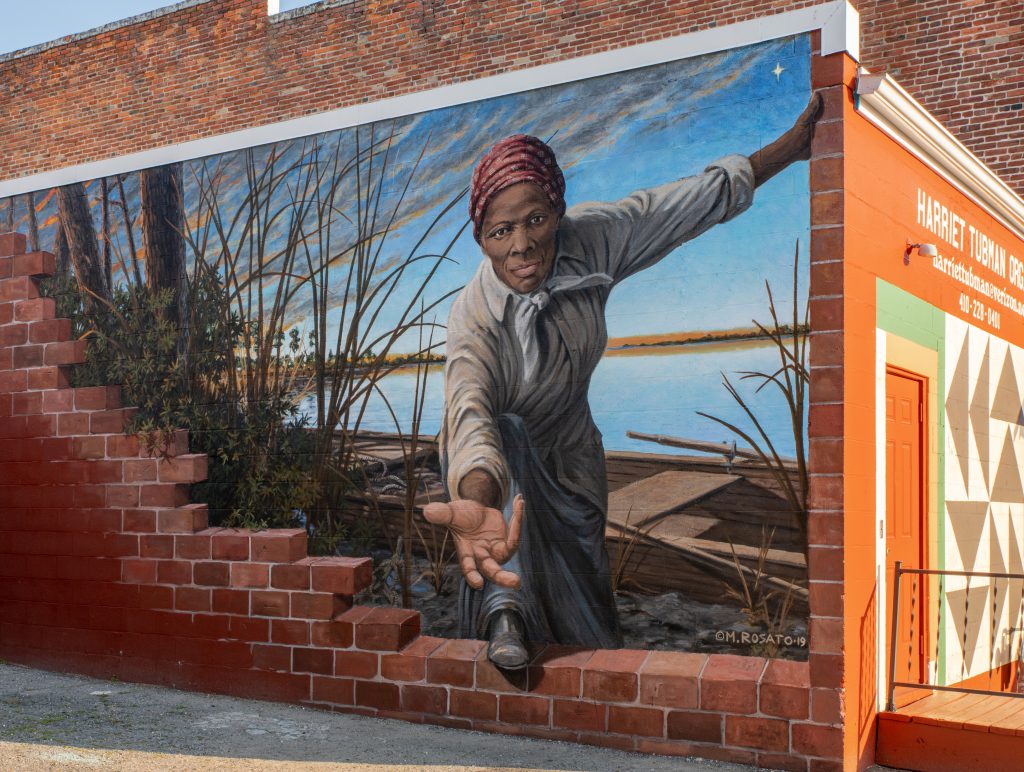Traveling in the Footsteps of Harriet Tubman: Celebrate Tubman’s Bicentennial in 2022

Harriet Tubman Museum and Educational Center mural. Photo courtesy of Dorchester County Visitors Center
Two hundred years ago, an American hero named Harriet Tubman was born in Dorchester County, Maryland. An Underground Railroad conductor, abolitionist, suffragist, veteran, and small business owner, Tubman overcame arduous odds to accomplish great feats. Today, the Harriet Tubman Underground Railroad Scenic Byway follows in her footsteps from her home in Dorchester County to freedom in Philadelphia. There are 45 sites to explore in total, and nearly half of the byway’s sites are located in Dorchester County.
A major stop along that route is the Harriet Tubman Underground Railroad State Park and Visitor Center, near Church Creek. The park celebrates its fifth year in operation this year, which is also the bicentennial of Tubman’s estimated birth year.
For anyone who wants to explore “Tubman Country,” the rangers at Harriet Tubman Underground Rail-road State Park picked some favorite sites to visit.
Harriet Tubman Museum and Educational Center (Site #5)
Operated by the nonprofit Harriet Tubman Organization, the volunteer-run Harriet Tubman Museum and Educational Center preserves artifacts, organizes events, and teaches visitors about Tubman’s continuing importance in the area where she grew up. Inside the museum are exhibits and a gift shop. A painted mural outside the museum, depicting Tubman reaching out to the viewer, went viral on social media in 2019.
“It’s nice to have a partner in interpretation, and I’m glad that so many visitors get to visit both the museum and the Visitor Center and get a well-rounded view of Tubman’s story,” said Seasonal Ranger Laurel Pogue. “All of the volunteers are knowledgeable and welcoming, and help make the museum a great experience.”
Joseph Stewart’s Canal/Parsons Creek (Site #10)
For more than two decades, enslaved and free Blacks toiled perilously to dig Stewart’s Canal, which connected the timbering and agricultural areas around the Blackwater River to the Little Blackwater River, the shipyards in Madison Bay, and destinations across the Chesapeake Bay. The seven-mile canal is still visible today, more than two hundred years after work on the canal began.
“The canal holds a dark history of slavery, but despite this, the sunsets over it remain breathtaking,” said Ranger Chaney Dale.
Harriet Tubman Underground Rail-road State Park and Visitor Center (Site #13)
Opened in 2017, the Visitor Center’s exhibits reveal the life and legacy of Harriet Tubman, with a focus on her early life here on the Eastern Shore. The exhibits are complemented with a theater, a park store, and a Legacy Garden that surrounds the Visitor Center.
“The Visitor Center offers guests an immersive and emotive experience, creating connections between modern day travelers and the 19th century. Our exhibits provide a strong foundation for exploring more of Tubman Country,” said Park Manager Dana Paterra.
Blackwater National Wildlife Refuge (Site #14)
Established to protect prime habitat for migratory birds, Blackwater National Wild-life Refuge also protects the natural environment as it was when Harriet Tubman lived in Dorchester County. The refuge’s Wildlife Drive takes visitors past a mixture of forest, swamp, and open water that have characterized southern Dorchester County for centuries.
“I love seeing the variety and sheer number of birds at Blackwater,” said Seasonal Ranger Adam Larson. “The bald eagles are there year-round, and from winter to summer you can watch as the huge flocks of geese are replaced by osprey nesting on platforms.”
Bucktown Village Store (Site #17)
When Harriet Tubman was about 12 years old, she went to the Bucktown Village Store on an errand. An enslaved man had entered the store without permission from his slaveholder, and an overseer had followed him there. The overseer told Tubman to restrain the enslaved man, but she refused. The overseer then took a weight and hurled it at the enslaved man, but missed and struck Tubman in the head. The near-fatal injury caused her to have vivid visions for the rest of her life that she believed were sent by God.
“You can visit the site where Harriet demonstrated her first act of defiance, and while her injury was physically devastating, it was spiritually awakening,” said Park Ranger Cierra Maszkiewicz.
Faith Community United Methodist Church (Site #21)
Churches were a cornerstone of the free and enslaved Black community, where preachers shared a vital message of empowerment and hope. The Reverend Sam Green, an Underground Railroad conductor, was one of the original trustees of Faith Community United Methodist Church, a congregation that still worships today.
“Faith Community Church is a center of the community where everybody meets and greets each other in a historically important congregation,” said Seasonal Ranger Mary Dennard. “We are a people that remember where we came from. We are products of the past.”
dnr.maryland.gov/publiclands
Adam Larson served as a 2021 seasonal ranger at Harriet Tubman Underground Railroad State Park. Article appears in Vol. 25, No. 1 of the Maryland Natural Resource magazine.



 1-888-373-7888
1-888-373-7888 233733
233733